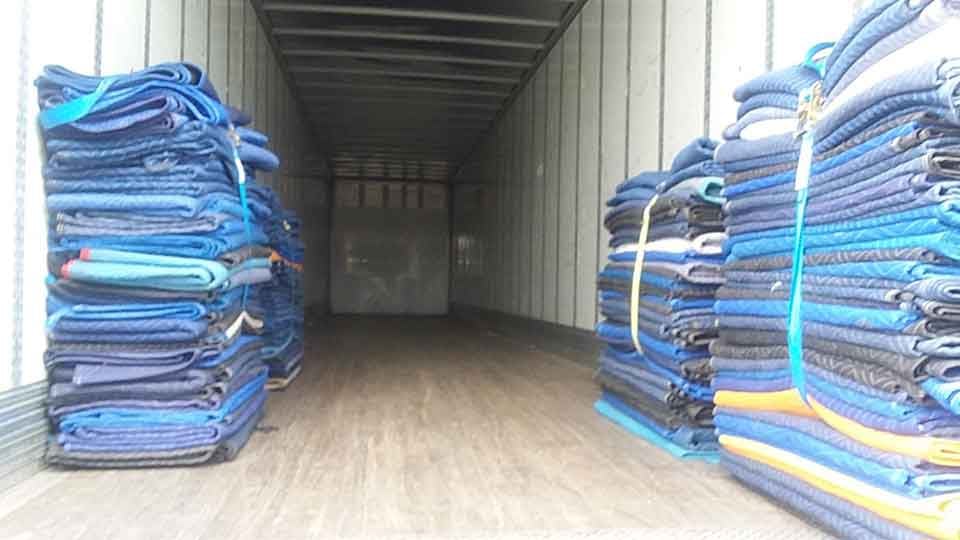You see it on every house flipping and DIY show: Wood flooring dominates the housing market. Homeowners love it because it is easy to clean, doesn’t hold dust and is suitable for most rooms.
Wood flooring also dominates the dry van market, where the choice is about more than aesthetics. Wood flooring provides a strong surface for hauling equipment and freight, and a clean slate for securement.
Over 68 years in the industry, Anderson Trucking Service (ATS) has seen a lot of innovation when it comes to trucks. While some of the materials may change over time, wood continues to be the best and most popular option for the floor of a dry van.
In this article, we will compare aluminum and wood flooring and compare the advantages of each. You will understand how the trailer’s flooring impacts loading and hauling freight, and be prepared to specify if you have a preference for future loads.
What Types of Trailer Flooring Are Available in the Trucking Industry?
Dry vans are available with two types of flooring: wood or aluminum.
However, if you know you require wood flooring for your freight, don’t leave it to chance. Include that information in your specification to avoid accessorial charges like a TONU.
Either type of flooring will work for most shipments. However, shippers of some specific items need to be aware of the materials used for the flooring in their truck. These shipments include:
- Dense, heavy equipment
- Food
- Items that need block-and-brace securement
When shipping any of these materials, work with your shipping provider to specify the type of trailer you require.
If you aren’t sure if the flooring type matters, ask your provider. Specify the commodity to be shipped, the total weight and the type of securement. With this information, your provider will match you to the correct vehicle.
Knowing the types of flooring available is one step toward sourcing the right vehicle for your load. Now let’s dive deeper into the strengths and weaknesses of each type of flooring.

What Are the Advantages of Wood Floors in Dry Vans?
Wood is by far the most common flooring material used in dry vans. There are several advantages to wood floors in dry vans:
- Customers can use block and brace securement, nailing wooden blocks to the floor to keep materials in place.
Block and brace is commonly used to keep freight from sliding around during transit, and it’s the best securement method for freight that can be damaged by strapping it to the wall, including heavy equipment and some barrels.
The hard wood used for truck wood flooring is sturdy enough to withstand many years of blocking and bracing, where the wooden blocks are repeatedly nailed to the flooring and then removed at the end of the load. Nails used are not long enough to fully penetrate the floor, keeping a sealed, dry van interior.
Food grade vans cannot have nail holes in the flooring. Vans dedicated to keeping that food-grade interior don’t allow block and brace. This is why it’s vital to specify if you will be using block and brace so your provider sends an appropriate vehicle. - The grain of the wood provides a textured surface for forklifts, pallet jacks and other equipment. Even when the surface of the flooring is damp, tires can find traction on a wood surface. The slick surface of an aluminum floor can cause hazards during loading and unloading.
- Point capacity on a wood floor is 20,000 pounds. This is enough to safely haul forklifts, dump buggies and other heavy equipment.
Most aluminum floors have a 16,000 pound rating. If sending heavy freight, make sure your truck is rated to the right weight.
Wood floors are the norm in the vast majority of dry vans on the road today. However, aluminum floors have their own advantages, and they are still commonly found in a carrier’s fleet.
What Are the Advantages of Aluminum Floors in Dry Vans?
A smaller percentage of trucks on the road have aluminum floors. They are popular with some drivers because they weigh slightly less than wood floors — about 1,000 pounds. This means they are easier to handle, they are slightly more fuel efficient.
Aluminum floors are easier to clean, making them a requirement when surfaces need to be clean enough to eat off of. The majority of reefer and food-grade trailers have aluminum floors for this reason.
Wood and aluminum floors work equally well for most types of freight. It’s when the floor of the truck is damaged that the owner will notice a significant difference.
What Type of Wood Are Truck Trailers Made Of?
Today’s wood floors start with a hard wood composite like oak or maple, which provides the strength of the flooring.
The wood is preserved with a double coat of polymer sealant, which provides a water-resistant surface without losing the texture of the wood. Coated wood is the visible surface of the flooring when you look inside the trailer from the back door.
Most trucks also have a steel threshold plate inside the door of the trailer. This plate protects the wood from moisture that enters that trailer through the door: precipitation that comes in while the truck is loading or unloading, or dampness on equipment coming in and out of the trailer.
Underneath the truck is a layer of fiberglass, which protects the wood from road debris or elements that could crack the wood or cause pitting.
Safety is always the first priority in trucking. Every portion of the wood floor is designed to withstand constant movement, shifting freight, equipment used during loading and unloading, and even nails being hammered in and torn out.
While wood floors aren’t suitable for every application, they are the best choice for most situations.
Repairing a Dry Van Floor: Wood vs. Aluminum
Heavy duty truck usage is likely to damage the trailer floor over time. The ability to repair the flooring is another key difference between aluminum and wood floors.
Aluminum floors are difficult to repair. They are most often made of one sheet of metal, which must be replaced in case of damage. If a heavy object damages the aluminum floor, this results in an expensive and time-intensive replacement.
Wood floors are constructed of individual panels tongue-and-grooved together. If one panel is damaged, or if damage occurs to several panels in one area, just the damaged areas can be replaced. This means less time and money invested in maintaining the wood floor over time.
How Do Truck Floors Withstand Moisture?
When wet, an aluminum surface can easily be dried without needing any further attention. Untreated wood is vulnerable to rot, especially when water collects for a long period of time. Fortunately, today’s wood floors combat rot.
The areas of the floor that are most exposed to the elements — the roadside fiberglass panel and the steel plate threshold — aren’t actually made of wood. The polycoat seal means that any moisture that does get into the truck beads up and dries before seeping into the wood.
Of course, the best way to avoid expensive and time-wasting repairs is to avoid damage to the truck in the first place. For most commodities, a wood floor is less likely to sustain damage. Some items will require a wood floor to avoid disaster.
What Commodities Must Be Shipped with a Wood Floor?
Because of their increased strength, wood floors are often required for dense commodities that place a lot of weight in one area — such as dump buggies or concrete carts, excavators and other construction equipment.
Wood floors may also be required for items that can’t be strapped to the side of the trailer, such as plastic barrels. Fragile commodities that need an additional level of securement can also use block and brace in addition to traditional straps.
Palleted freight may also require a trailer with wood flooring. If some parts of the trailer will be loaded two-across and some parts will be loaded one-across (due to total weight or weight distribution), block and brace may be needed to stop the single pallets from sliding.
Wood or Aluminum Flooring in Dry Vans: Which Is Right For You?
Dry van flooring is more than just a matter of aesthetics. The materials used to construct the vehicle itself are chosen to maximize safety and efficiency.
As a shipper, you can save the time and accessorial fees associated with the wrong type of vehicle arriving onsite by being thorough in your specifications. Be sure to include:
- The type of commodity
- Accurate dimensions (length, width, height and weight)
- Type of securement (strapping or block and brace)
Using this information, your provider will send a truck and driver to your point of origin that is ready to load and begin transit.
Ready to get started? Contact ATS for details and pricing information on your next shipment. Or continue your journey by learning more about the importance of an accurate specification.




